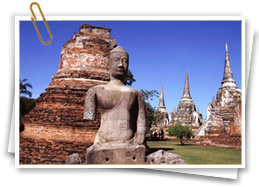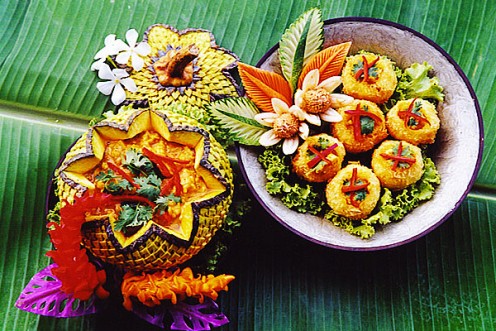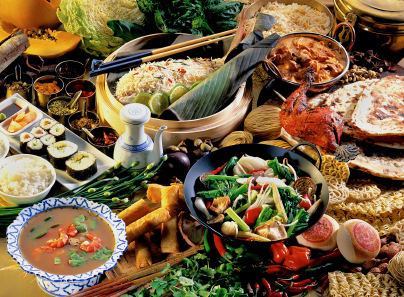



Thailand Food and Drink
Thai food is traditionally fairly hot and spicy, but most tourist restaurants tend to tone down the heat for the more fragile Western palate. Most Thai food is prepared with fresh ingredients such as lemon grass and coriander and rice is commonly eaten with most meals. Popular fruits are papaya, jackfruit, mangosteens, rambutans, pomelos (similar to grapefruits) and, above all, durians, which farangs (foreigners) either love or hate. The thorny fruits have a rather malodorous scent which has even resulted in many hotels banning them from their premises.

Excellent food can be found at the stalls of the many street vendors around the country as well as top-notch eateries. There are also many Asian and European restaurants throughout the major cities and smaller towns.
Specialities:
• Tom yam (a coconut-milk soup prepared with makroot leaves, ginger, lemon grass, prawns or chicken).
• Gang pet (hot 'red' curry with coconut milk, herbs, garlic, chili, shrimp paste, coriander and seasoning).
• Pad Thai (stir-fried rice-noodles) served with shrimp or chicken and garnished with peanuts.
• Desserts include salim (sweet noodles in coconut milk).
• Well worth trying is sticky rice and mangoes (rice cooked in coconut milk served with slices of mango).

Things to know:
Bars have counter or table service.
Tipping:
Most hotels and restaurants will add 10% service charge and 7% government tax to the bill.
Regional drinks:
• Mekhong (local whiskey) and SamSong (rum) are very popular.
• Singha and Singha Gold are locally made beers which dominate the domestic market.
• Coconut milk straight from the shell during the harvest season is particularly refreshing in the heat and humidity.
![]() Why Visit Thailand?
Why Visit Thailand?
![]() Thailand Travel Guide
Thailand Travel Guide
![]() Traveling to Thailand
Traveling to Thailand
![]() Thailand things to see and do
Thailand things to see and do
![]() Thailand Shopping and nightlife
Thailand Shopping and nightlife
![]() Thailand Food and Drink
Thailand Food and Drink
![]() Getting around Thailand
Getting around Thailand
![]() Bangkok Travel Guide
Bangkok Travel Guide
![]() Chiang Mai Travel Guide
Chiang Mai Travel Guide
![]() Ko Lipe Travel Guide
Ko Lipe Travel Guide
![]() Koh Phi Phi Travel Guide
Koh Phi Phi Travel Guide
![]() Ko Phangan Travel Guide
Ko Phangan Travel Guide
![]() Phuket Travel Guide
Phuket Travel Guide
![]() Thailand History, Language and Culture
Thailand History, Language and Culture
![]() Thailand Weather, climate and geography
Thailand Weather, climate and geography
![]() Thailand Travel Tips
Thailand Travel Tips
![]() Thailand Visa and Passport Requirements
Thailand Visa and Passport Requirements
![]() Thailand Satellite View & Map
Thailand Satellite View & Map
![]() Thailand Visa Information
Thailand Visa Information
![]() 3 Destinations in 1 Ticket
3 Destinations in 1 Ticket
We guide and assist for visa form download dubai hotel guide travel tourism dubai dubai satellite map dubai satellite images online hotel reservations worldwide travel & tourism hajj and umrah tour packages travel insurance for all European Embassies & Visa Requirements star holidays starholidays faisalabad pakistan BEST PIA FARES FROM UK TO PAKISTAN pia agent lyallpur aviation sajjad rao
Keywords Cloud
hotels tours ticketing visa insurance hajj umrah blueline visa information Dubai hotel bookings Cheap air ticketing hajj umrah tour packages travel insurance travel reservations contact Star Ho;idays travel insurance around the world round the clock special offer on dubai hotels hotel booking guide star holidays tour packages lowprice dubai happy holidays visit visa china visit visa dubai visit visa singapore visit visa malaysia visit visa thailand visit visa hong kong visit visa egypt visit visa uzbekistan visit visa indonesia visit visa russia visit visa bangladesh
Star Holidays is a fast growing tour operator and travel agent in Pakistan we have been in the Asian Countries travel and tourism business since 1997 started as an approved agent of Pakistan international airlines (PIA) more than 15 years ago our company has established itself as a reputed concern offering multi-product travel services. at star holidays you will find a team of dedicated professionals each contributing their optimum expertise to deliver and ensure complete satisfaction of our clients our highly experienced staff members are ready to serve you from the time you think to travel we ensure you hassle free and comfortable travel at affordable price we provide a wide selection of hotels and apartments in Dubai with online confirmation through years of experience and goodwill generated between us and our partner suppliers in the tourism and travel sector we can offer you the best available rates ever offered find more China Tours Dubai Tours Singapore Tours Malaysia Tours Thailand Tours Hong Kong Tours Egypt Tours Vietnam Tours Indonesia Tours Uzbekistan Tours Azerbaijan Tour Russia Tours Bangladesh Tours
and travel insurance around the
world
Star Holidays free visas
information web, which contain information for the visas for all embassies in Pakistan our goal is
to provide you with professional competent and experienced service which will help you accomplish your
personal immigration goals find more for Australia visa requirements, Austria visa requirements, Azerbaijan visa requirements, Bangladesh visa requirements, Belgium visa requirements, Brasil visa requirements, Bulgeria visa requirements, Canada visa requirements, China visa requirements, Cyprus visa requirements, Czech visa requirements, Denmark visa requirements, Dubai visa requirements, Egypt visa requirements, Finland visa requirements, France visa requirements, Germany visa requirements, Greece visa requirements, Greenland visa requirements, Hong Kong visa requirements, Hungary visa requirements, India visa requirements, Indonesia visa requirements, Iran visa requirements, Ireland visa requirements, Italy visa requirements, Japan visa requirements, Jordan visa requirements, Kazakhstan visa requirements, Kenya visa requirements, Korea visa requirements, Lebanon visa requirements, Libya visa requirements, Malaysia visa requirements, Mauritius visa requirements, Mexico visa requirements, Morroco visa requirements, Nepal visa requirements, Netherland visa requirements, New Zealand visa requirements, Nigeria visa requirements, Norway visa requirements, Oman visa requirements, Pakistan visa requirements, Philippines visa requirements, Poland visa requirements, Portugal visa requirements, Romania visa requirements, Russia visa requirements, Saudia Arabia visa requirements, Singapore visa requirements, South Africa visa requirements, Spain visa requirements, Sri Lanka visa requirements, Sweden visa requirements, Switzerland visa requirements, Syria visa requirements, Taiwan visa requirements, Tajikistan visa requirements, Thailand visa requirements, Turkey visa requirements, UK visa requirements, Ukraine visa requirements, USA visa requirements, Uzbekistan visa requirements,
Star Holidays worldwide embassies archived web find more tour packages find more airlines tariff click for PIA net fares click for thai net fares click for emirates net fares Embassies in Pakistan Pakistani embassies abroad worldwide embassies star holidays online travel tour agent in Pakistan. we provide a wide selection of hotels and apartments with online confirmation visa information immigration and visa assistance hajj umrah tour packages and Worldwide travel insurance through years of experience and goodwill generated between us and our partner suppliers in the tourism and travel sector we can offer you the best available rates ever offered.
We guide and assist for visa
form download dubai hotel
guide travel
tourism dubai dubai
satellite map dubai
satellite images online
hotel reservations worldwide travel &
tourism hajj and umrah
tour packages travel
insurance for all European Embassies & Visa Requirements star holidays starholidays faisalabad
pakistan BEST PIA
FARES FROM UK TO PAKISTAN
pia agent lyallpur aviation sajjad rao
Keywords Cloud
hotels tours ticketing visa insurance hajj umrah blueline visa information Dubai hotel bookings Cheap air ticketing hajj umrah tour packages travel insurance travel reservations contact Star Ho;idays travel insurance around the world
round the clock special
offer on dubai hotels hotel
booking guide star
holidays tour packages lowprice dubai happy
holidays visit visa
china visit visa
dubai visit visa
singapore visit visa
malaysia visit visa
thailand visit visa hong
kong visit visa
egypt visit visa
uzbekistan visit visa
indonesia visit visa
russia visit visa
bangladesh